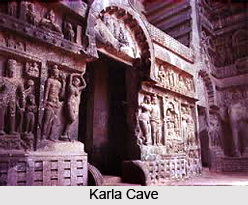 The caves at Karle and Bhaja illustrate the Buddhist art. The magnificent chaitya hall at Karle features the skills of art. There are total 18 caves located in Bhaja, belonging to the 2nd century BC situated near Pune, in Maharashtra. These caves have been given numbers and out of these ones, no.12 is the largest cave, which is noted for the fine stilted vault. Here, an arched structure found in sculpturing is very much different from other caves.
The caves at Karle and Bhaja illustrate the Buddhist art. The magnificent chaitya hall at Karle features the skills of art. There are total 18 caves located in Bhaja, belonging to the 2nd century BC situated near Pune, in Maharashtra. These caves have been given numbers and out of these ones, no.12 is the largest cave, which is noted for the fine stilted vault. Here, an arched structure found in sculpturing is very much different from other caves.
The last cave to the south has excellent sculptures including that of the famous `Dancing Couple`. Bhaja Caves are similar to Karla Caves when compared for scale of carvings. The Buddhist caves of Bhaja also follow a distinct style, the Chaitya style through its carvings. One more specialty is that, these caves are constructed such as the rays of the setting sun gilds the dark interiors where sculptured figures of gods and goddesses are carved.
Distinct from the Bhaja caves, the Buddhist architects of Karle are famous for the cave sculptures. The sculptures of this place depict about Buddha. The cave is larger than Bhaja and preserved in a best way. The caves are carved on the black rock that lies on a flat terrace, several hundred feet above the base of hill. Inside the cave, there are the three doorways & panels of figures comprising six couples, presumed to have been the wealthy patrons of the hall. Two rows of octagonal columns with pot-shaped bases seem to divide the interior part of cave into three. This forms a wide central area and at the outside, a hall that allowed devotees to circumambulate the monolithic stupa at the back.
 The structure at the above of each pillar is carved with a finely carved elephant mounted by two riders, one with arms draped over the other`s shoulders. The teak ribs on the vaulted ceiling show that the stone was carved to resemble a wooden structural model. The remains of the carved wooden umbrella surmount the architecture of stupa. The stupendous carvings on the chaitya`s front wall are carved in continuous manner without stopping till the entrance of the cavernous hall. This cave is marked with the presence of chaityas, which are meant to be solemn prayer halls and stupas, as a representative of the Buddha articles of worship. The 2000-year-old chhatri at the top of the Karle stupa is made of wood.
The structure at the above of each pillar is carved with a finely carved elephant mounted by two riders, one with arms draped over the other`s shoulders. The teak ribs on the vaulted ceiling show that the stone was carved to resemble a wooden structural model. The remains of the carved wooden umbrella surmount the architecture of stupa. The stupendous carvings on the chaitya`s front wall are carved in continuous manner without stopping till the entrance of the cavernous hall. This cave is marked with the presence of chaityas, which are meant to be solemn prayer halls and stupas, as a representative of the Buddha articles of worship. The 2000-year-old chhatri at the top of the Karle stupa is made of wood.
The arched rafters function as supporting means of the cave ceiling, which are also wooden. The stupa of the cave is suffering from the faith of people, who believe that the stupa is in a lingam appearance. So, flowers and sindoor were seen at some places. The pillars had beautifully carved capitals, depicting divine couples sitting astride elephants. And the bases of pillars are bulged out like pots.
One more important feature at Karle was the existence of multi-storeyed viharas (chambers). This gives birth to a question that why did the monks choose to carve up to the second floor when it was easily possible to create viharas at the ground level. But this question remains unanswered, as no records except the sculptures have remained.



